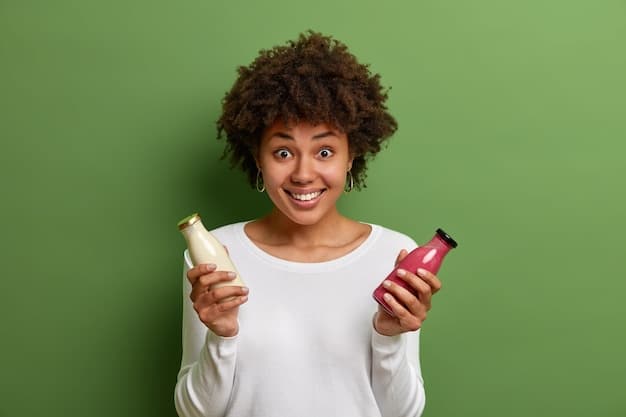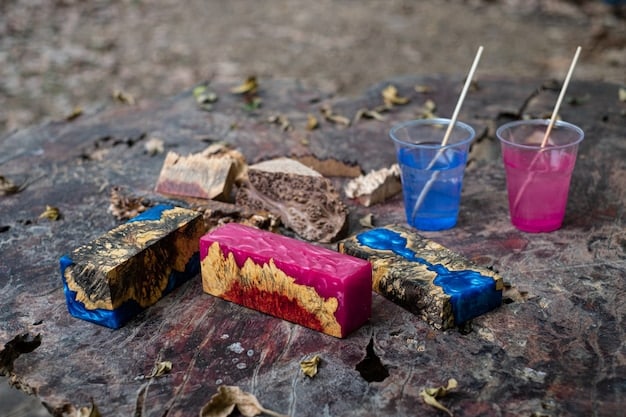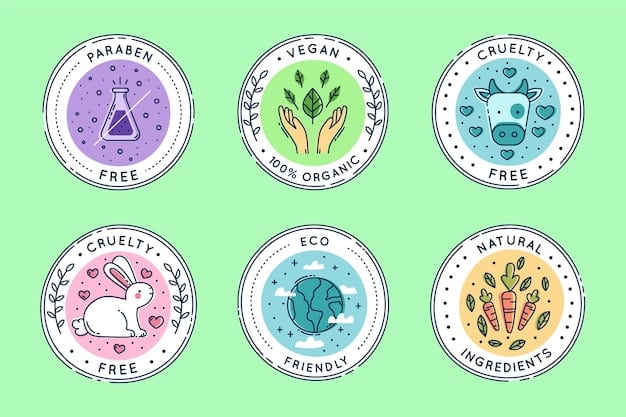Eco-Friendly Personal Care: Your Comprehensive Guide

How to Choose Eco-Friendly Personal Care Products: A Comprehensive Guide explores sustainable options, from understanding ingredient labels to supporting ethical brands, for a healthier planet and personal well-being.
Switching to eco-friendly personal care products is a wonderful way to reduce your environmental impact and support sustainable practices. This how to choose eco-friendly personal care products: a comprehensive guide will help you navigate the world of green beauty and make informed decisions.
Understanding the Impact of Conventional Personal Care Products
Conventional personal care products often contain harmful chemicals and unsustainable ingredients that can negatively impact both your health and the environment. Understanding these impacts is the first step toward making more conscious choices.
The Chemical Concerns
Many conventional products contain chemicals like parabens, phthalates, and sulfates, which have been linked to various health issues and environmental damage. These substances can pollute waterways, harm aquatic life, and disrupt ecosystems.
Packaging Waste
Traditional personal care products often come in plastic packaging that contributes to landfill waste and ocean pollution. The reliance on single-use plastics in the beauty industry is a significant environmental problem.

To minimize these impacts, consider the following:
- Read Labels Carefully: Look for products that are free from harmful chemicals and synthetic fragrances.
- Choose Sustainable Packaging: Opt for products with minimal, recyclable, or biodegradable packaging.
- Support Ethical Brands: Look for companies committed to sustainable sourcing and cruelty-free practices.
By understanding the environmental and health impacts of conventional products, you can make informed decisions and choose eco-friendly alternatives that align with your values. This shift not only benefits the planet but also your personal well-being.
Key Ingredients to Avoid in Personal Care Products
Knowing which ingredients to avoid is crucial in choosing eco-friendly personal care products. Many harmful chemicals found in conventional products can be detrimental to both your health and the environment.
Harmful Chemicals
Certain chemicals commonly found in personal care products have been linked to health issues, such as endocrine disruption, skin irritation, and even cancer. Avoiding these substances is a significant step toward making safer choices.
Environmental Pollutants
Many ingredients can pollute waterways and harm aquatic life when they are washed down the drain. Choosing products free from these pollutants helps protect the environment.
Here’s a list of ingredients to watch out for:
- Parabens: Used as preservatives, parabens can disrupt hormone function.
- Phthalates: Often found in fragrances, phthalates are endocrine disruptors.
- Sulfates (SLS/SLES): Harsh detergents that can cause skin irritation and water pollution.
- Triclosan: An antibacterial agent that can harm aquatic ecosystems.
By being aware of these ingredients and actively avoiding them, you can significantly reduce your exposure to harmful chemicals and support a healthier planet. Always take the time to read labels and make informed choices.
Decoding Eco-Friendly Labels and Certifications
Navigating eco-friendly labels and certifications can be a challenge. Understanding what these labels mean can help you make informed choices and support brands that are truly committed to sustainability.
What to Look For
Eco-friendly labels and certifications indicate that a product meets certain environmental and ethical standards. These labels can cover various aspects, from ingredient sourcing to packaging practices.
Common Certifications
Many different certifications exist, each with its own set of criteria. Familiarizing yourself with these labels can help you identify genuinely sustainable products.

Here are some common certifications and what they signify:
- USDA Organic: Indicates that a product contains at least 95% organic ingredients.
- Leaping Bunny: Certifies that a product is cruelty-free and not tested on animals.
- Fair Trade: Ensures that producers and workers receive fair wages and safe working conditions.
Understanding these labels can simplify the process of choosing eco-friendly personal care products. Look for recognizable certifications to ensure that the products you buy meet credible sustainability standards. This knowledge empowers you to support brands that align with your environmental values.
Sustainable Packaging Options and Innovations
Packaging plays a significant role in the environmental impact of personal care products. Choosing products with sustainable packaging options can significantly reduce waste and support a circular economy.
Reducing Plastic Waste
Traditional plastic packaging is a major source of pollution. Seeking out alternatives to single-use plastics is essential for reducing your environmental footprint.
Innovative Solutions
Many companies are developing innovative packaging solutions that minimize environmental impact. These innovations range from recyclable materials to biodegradable options.
Consider these sustainable packaging options:
- Recyclable Packaging: Look for products in materials like glass, aluminum, or recyclable plastics.
- Biodegradable Packaging: Opt for packaging made from plant-based materials that can break down naturally.
- Refillable Systems: Support brands that offer refillable options to reduce the need for new packaging.
By choosing products with sustainable packaging, you can actively contribute to reducing plastic waste and supporting a more circular economy. Prioritize brands that are committed to innovative and eco-friendly packaging solutions.
DIY Personal Care Products: A Sustainable Alternative
Making your own personal care products is a sustainable and cost-effective alternative to buying conventional options. DIY products allow you to control the ingredients and reduce packaging waste.
Benefits of DIY
Creating your own products offers numerous benefits, including reducing your exposure to harmful chemicals, minimizing waste, and saving money.
Simple Recipes
Many simple and effective recipes can be easily made at home using natural ingredients. These recipes often require minimal ingredients and equipment.
Here are some easy DIY personal care product ideas:
- Homemade Face Scrub: Mix sugar with coconut oil for a gentle exfoliating scrub.
- DIY Shampoo: Combine baking soda with water for a clarifying shampoo.
- Natural Deodorant: Use coconut oil, baking soda, and essential oils for a chemical-free deodorant.
Embracing DIY personal care products can be a rewarding way to reduce your environmental impact and customize your skincare routine. Experiment with different recipes to find what works best for you, and enjoy the benefits of natural, homemade products. This approach not only promotes sustainability but also enhances your connection to the ingredients you use.
Supporting Ethical and Sustainable Brands
Choosing to support ethical and sustainable brands is an excellent way to promote environmentally responsible practices. These brands prioritize sustainability, fair labor practices, and environmental conservation.
What to Look For
Ethical and sustainable brands are transparent about their sourcing, manufacturing processes, and environmental impact. Look for companies that prioritize these values.
Research Brands
Take the time to research brands and learn about their sustainability initiatives. Many companies openly share information about their practices on their websites.
Consider these factors when choosing brands:
- Transparency: Does the brand provide clear information about its sourcing and manufacturing processes?
- Certifications: Does the brand hold any relevant eco-friendly or ethical certifications?
- Community Impact: Does the brand support local communities or environmental initiatives?
By supporting ethical and sustainable brands, you can encourage responsible business practices and contribute to a more sustainable future. Your purchasing power can drive positive change in the beauty and personal care industry.
| Key Aspect | Brief Description |
|---|---|
| 🌱 Ingredients | Avoid harmful chemicals like parabens and sulfates. |
| ♻️ Packaging | Choose recyclable or biodegradable options. |
| 🐇 Cruelty-Free | Look for Leaping Bunny certification. |
| 🏠 DIY | Make your own to control ingredients and reduce waste. |
Frequently Asked Questions
▼
Eco-friendly personal care products use sustainable ingredients and packaging, avoid harmful chemicals, and are often cruelty-free.
▼
Read the ingredient list carefully and avoid products with parabens, phthalates, sulfates, and synthetic fragrances.
▼
Look for products with recyclable, biodegradable, or refillable packaging options to reduce waste.
▼
Yes, many DIY recipes use natural ingredients that are effective and gentle for your skin and hair.
▼
Research brands, look for certifications, and choose companies committed to transparency and fair labor practices.
Conclusion
Choosing eco-friendly personal care products is a significant step towards a more sustainable lifestyle. By understanding the impacts of conventional products, identifying harmful ingredients, decoding eco-friendly labels, embracing sustainable packaging, and supporting ethical brands, you can make informed choices that benefit both your health and the environment.





